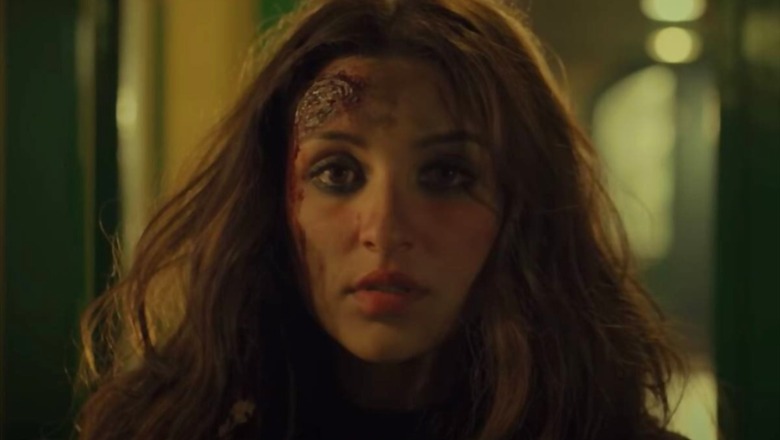
views
Anyone who has read British author Paula Hawkins’ The Girl on the Train, knows that the charm of the novel lies in her metaphors. From the beginning, The Girl on the Train captivates you, it is a book that you cannot put down and if you are willing to go through the repercussions, it is a piece that you can finish in one sitting. It is massively entertaining, with a lead character who is layered and unpredictable that you don’t know how to feel about her. Long story short, it has earned all the acclaim and success it has received.
In 2016, the film was turned into a major motion picture starring Emily Blunt as the protagonist. The film boasted of a star-studded ensemble with Haley Benner, Justin Theroux, Allison Janney, Lisa Kudrow, and many others playing pivotal roles in the film. The film’s premise looked like a sure shot success, but a lot of die-hard fans of the book complained that the film did not match up to their expectations. One of the major issues for the fans was that the film was set in New York City instead of London. According to fans, the geography of the book was an important part of the charm, and hence when they changed it, the film felt foreign and distant from the manuscript.
Ribhu Dasgupta, who wrote and directed the Hindi adaptation, might have been aware of the fact. Hence the 2021 film starring Parineeti Chopra, Aditi Rao Hydari and Kirti Kulhari was set in London. A film which already has predecessors in the form of a hugely popular book and show, will obviously not be judged very kindly. However, a film like that is also at an advantage because the makers already have a formula for success. They just need to smartly decide what they can do to give an originality to this remake. When they decided to set the film in London, they were probably trying to undo the mistake of the Hollywood film, however, the move misfired by a lot.
Parineeti Chopra’s character Meera Kapoor is an alcoholic divorcee, who is also unemployed. She is a lawyer by profession, and a resident of London, who met her ex-husband in a ‘Desi’ wedding in London. She also made a powerful enemy by convicting an Indian gang-leader for murder, and his well wishers retaliated by causing a car crash where she lost her unborn child. After she becomes increasingly dependent on alcohol and seemingly abusive towards her husband, he leaves her for another woman. She then makes it a habit to take the same train through which she can look into the lives of her ex, his new wife and the couple that lives next-door to him.
She becomes obsessed with this new couple, especially the woman Nusrat John, who seems to be the embodiment of everything she lost. One day when her voyeuristic obsession with Nusrat reaches a peak, she finds herself outside her door in a seething rage. When Nusrat goes missing, Mira can’t remember if she was the one who killed her. The missing person case is taken up by Inspector Dalbir Kaur Bagga, and her colleague is also an Indian man.
Basically, every important character in the film is Indian or South Asian. Of course, there is a large diaspora of NRIs living in London. It is not a big deal if they are lawyers or police officers or psychiatrists or even dead girls found in a forest. One can argue that this is cinema and not real life, hence suspension of disbelief can be warranted. However, even a film has the responsibility to make sense and be logical.
In a scene, where Mira Kapoor is sitting in what seems to be an alcoholics anonymous meeting, she goes on and on about her past and present being destroyed by alcohol. She talks about how she must remember what happened the night Nusrat was killed to fix her future. Firstly, this sounds like a confession to a group of strangers, who have no obligation to you if you are the prime suspect on a murder case. But that is not what’s absurd about this scene. The group she has been talking to is a diverse bunch, with the White man and the Black woman not only understanding what she is saying in Hindi, but also giving her pained looks of sympathy. If this is weird, so is the fact that every South Asian character in the film happens to be Hindi speaking. Just because a film is a Hindi remake, doesn’t necessarily mean that all the dialogues need to be in Hindi.
Talking about dialogues, there is an unnecessary amount of heaviness in the things that every character is made to say. Remember when Varun Dhawan and Alia Bhatt’s characters in Kalank spoke in shayaris? Remember how tiring it was because no one in real life spoke like that? If you are portraying your film as a smart and sleek thriller, what is the use of all the filmy dialogue-baazi? We can see that your protagonist is an alcoholic who roams around London chugging Vodka, you don’t have to make your character say that too.
Also the audience must see the protagonist as a damaged soul, but someone who might very well have committed the murder. But her many narrations throughout the film are laden with melodrama, she starts feeling like a bore.
The only enticing part of the Netflix film was when Mira finds out that her ex Shekhar might actually be gaslighting her. Near the final act, we find out Shekhar has been lying to Mira about being an abusive alcoholic. He is actually the one who forced Mira to drink more than she could handle, and inflicted injuries on himself to make it look like Mira physically abused him. This gives the film another layer, making it not just a normal whodunnit but a psychological thriller. However, we waste so much time seeing Mira walking on the streets crying, swerving or tumbling to show she is an alcoholic, doing a Deepika Padukone in Cocktail type dance along in a nightclub, and rant on and on about how Shekhar left her, that this sequence gets rushed and reduced to a ploy for the final resolution.
The Girl on the Train had infinite potential. It had a tried and tested formula for success. It had a unique set-up, mysterious characters and even a great twist in the climax. However, so much time was spent making it a Bollywood-approved ‘Masala’ film that it actually missed out on the great opportunity. Cinephiles usually don’t like saying ‘the book was better’ as it is usually coloured with prejudice. However, in the case of The Girl on the Train, the book was so much better.
Read all the Latest News, Breaking News and Coronavirus News here



















Comments
0 comment